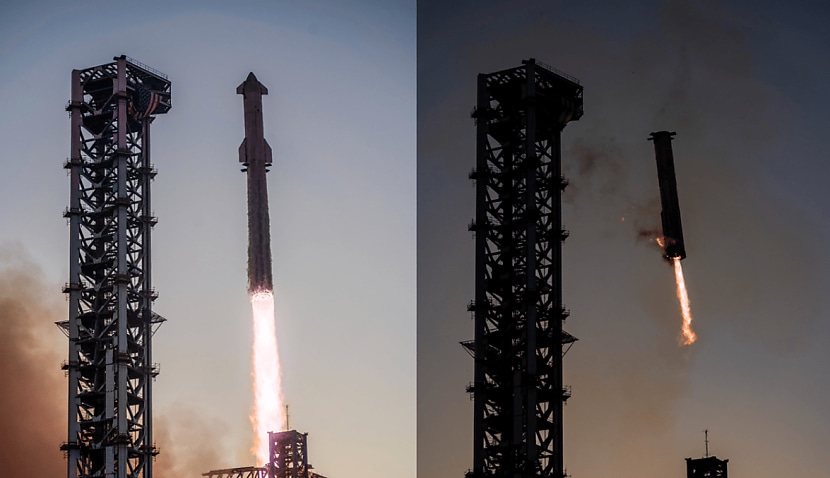
The sixth test will also make a number of tweaks from the previous mission that aim to bring the system closer to being fully reusable, including changes to its thermal protection system.
Starship is the collective name for the SpaceX Super Heavy booster rocket and Starship spacecraft, destined to fly humans to Mars one day.
Last month it completed its fifth test, but the first where the Super Heavy booster was dramatically caught by mechanical arms attached to its launch tower.
SpaceX said the next flight would aim to “expand the envelope on ship and booster capabilities”.
“Objectives include the booster once again returning to the launch site for catch, reigniting a ship Raptor engine while in space, and testing a suite of heat shield experiments and manoeuvring changes for ship re-entry and descent over the Indian Ocean,” SpaceX said in a statement.
“The success of the first catch attempt demonstrated the design feasibility while providing valuable data to continue improving hardware and software performance.
“Hardware upgrades for this flight add additional redundancy to booster propulsion systems, increase structural strength at key areas, and shorten the timeline to offload propellants from the booster following a successful catch.
“Mission designers also updated software controls and commit criteria for the booster’s launch and return.
“Analogous to the fifth flight test, distinct vehicle and pad criteria must be met prior to a return and catch of the Super Heavy booster, which will require healthy systems on the booster and tower and a final manual command from the mission’s flight director.”
SpaceX added Starship would fly the same suborbital trajectory as the previous flight test, with splashdown targeted in the Indian Ocean.
An additional objective will also be attempting an in-space burn using a single Raptor engine in an effort to demonstrate the capabilities required to conduct a ship deorbit burn.
“Several thermal protection experiments and operational changes will test the limits of Starship’s capabilities and generate flight data to inform ship catch and reuse plans,” SpaceX said.
“The flight test will assess new secondary thermal protection materials and will have entire sections of heat shield tiles removed on either side of the ship in locations being studied for catch-enabling hardware on future vehicles.
“The ship also will intentionally fly at a higher angle of attack in the final phase of descent, purposefully stressing the limits of flap control to gain data on future landing profiles.
“Finally, adjusting the flight’s launch window to the late afternoon at Starbase will enable the ship to re-enter over the Indian Ocean in daylight, providing better conditions for visual observations.”
Starship’s first launch failed to reach orbit in April last year but surpassed expectations by crucially passing through Max Q, the period in which the spacecraft endures maximum dynamic pressure.
A second launch in November went one better with a successful first-stage separation, and the third launch in March 2024 finally reached orbit but without a successful soft landing.
The fourth launch, though, in June, was hailed by Musk as a “great day for humanity’s future as a spacefaring civilisation” after it conducted a soft splashdown for the first time.
However, the company crucially didn’t attempt to recover the upper stage when it executed a “flip manoeuvre” and came to a rest in the Indian Ocean.
Michael Brown, an associate professor from Monash University’s School of Physics and Astronomy, said the return of the first stage booster during the fifth flight was a “technical triumph that has caught public attention”.
“The test flight represents a milestone on the path towards a fully reusable rocket that can lift 100 tonnes of payload into orbit,” he said.
“SpaceX has previously recovered smaller first-stage boosters from Falcon rockets, which have landed on barges or concrete pads. In contrast, the Starship booster returned to its launch site, which offers the prospect of it being refuelled and relaunched from the same site.
“The reusability of Falcon rocket boosters has helped SpaceX reduce costs and dominate the commercial launch market. Increasing reusability and minimising the refurbishment required before relaunching could further reduce costs with Starship.
“This could open the door to ambitious space exploration later this decade and beyond. However, I suspect a fully reusable Starship will initially be used for commercial launches into Earth orbit, including vast satellite constellations.”

Adam Thorn
Adam is a journalist who has worked for more than 40 prestigious media brands in the UK and Australia. Since 2005, his varied career has included stints as a reporter, copy editor, feature writer and editor for publications as diverse as Fleet Street newspaper The Sunday Times, fashion bible Jones, media and marketing website Mumbrella as well as lifestyle magazines such as GQ, Woman’s Weekly, Men’s Health and Loaded. He joined Momentum Media in early 2020 and currently writes for Australian Aviation and World of Aviation.
Receive the latest developments and updates on Australia’s space industry direct to your inbox. Subscribe today to Space Connect here.









